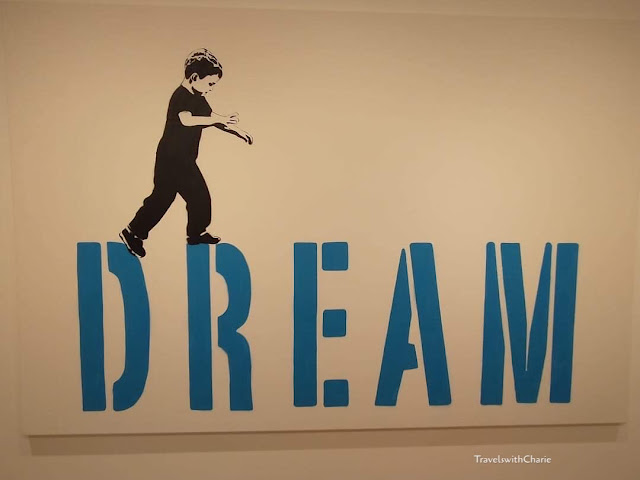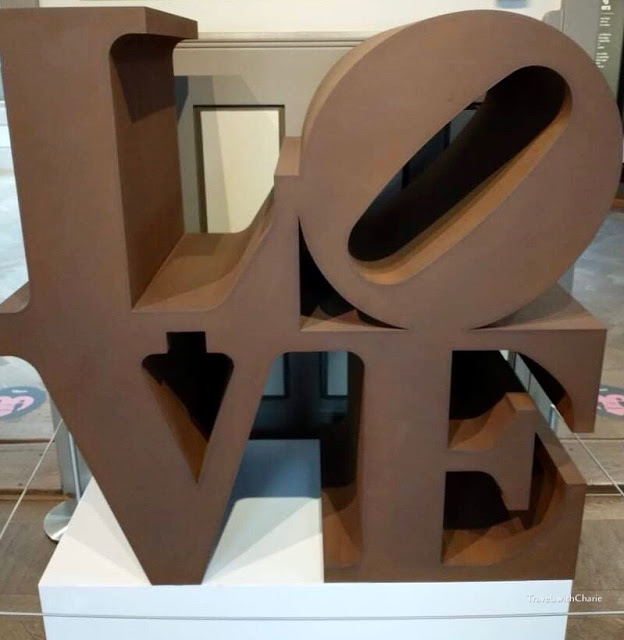The more of you, The more I love you, Tracey Emin, Neon text
"There should be something revelatory about art. It should be totally creative and open doors for new thoughts and experiences." Tracey Emin
I am drawn to Emin’s poignant neon messages created from her own handwriting. It's as if she's telling us something of herself.

The Battle of the Beanfield, Banksy
On June 1, 1985, Wiltshire Police Officers stopped about 600 people on their way to attend the Stonehenge Summer Festival. What was to be a cultural celebration turned into a bloody confrontation that sent 8 police officers and 16 travelers to the hospital. 537 travelers were later arrested in the largest mass arrest since World War II. Why? There are several reasons claimed by both sides. One is the view held by police that these attendees were a direct threat because of their hippie lifestyle.
Laugh Now is an art exhibition of Banksy’s indoor pieces on canvas, wood and paper. It is not authorized by the artist. The artworks on display have been validated by Pest Control, the only official authenticator of Banksy’s works. Read my full article about the Banksy art exhibition here: https://www.travelswithcharie.com/2021/08/laugh-now-banksy-at-moco.html

Dream, Icy & Sot, 2018, spray paint on canvas
Known as the Banksy of Iran, the works of these brothers are controversial in their own country and are banned there.
oil painting and egg tempera on canvas
The Kid questions the social and political issues confronting the youth today.
Green Pumpkin, Yayoi Kusama, 1992, acrylic on canvas
“My art originates from hallucinations only I can see. I translate the hallucinations and obsessional images that plague me into sculptures and paintings. All my works in pastels are the products of obsessional neurosis and are therefore inextricably connected to my disease. I create pieces even when I don’t see hallucinations, though.” Yayoi Kusama
Dollar, Andy Warhol, 1982
Silkscreen on handkerchief mounted on cardboard
From the master of consumer culture, Dollar poses the idea that art and wealth are synonymous.
Ink and gouache on paper
Keith Haring was a proponent of “art is for everybody” and he wanted as many people to see his artworks. As the phone connects people, Haring believed art connects and brings us together.
Tempter, Marcel Wanders, 2016, bronze and rubber
“I don’t want to get old to realize that I haven’t lived.” Marcel WandersFinal Days, KAWS, 2016, Afrormosia wood
Afrormosia is African wood that is believed to hold spiritual energy. The sculpture has its arms open and is reaching out to the viewer. Let that energy flow!
Vandal Gummy, WhIsBe, 2006, fiberglass
“The sweet life is just a fantasy.” MOCO brochure
“It is the projection of a childhood memory. It’s large leaves form a shelter under the sun, away from reality, just like those of the imaginary jungle that grows in the room of a child who seeks escape.” Marc Ange
Thinking of you, Adam Parker Smith, 2019
Studio Irma Digital Immersive Art
“Reflecting Forward expresses endless connections to reveal what the future can look like.” MOCO
On the heels of the amazing success of the Klimt and Van Gogh digital immersive art exhibitions worldwide, it was a pleasure to immerse myself in the world of Studio Irma. The diamond matrix, bubbles, dots and kaleidoscope experiences were amazing and to think these exhibitions were in far smaller rooms than the art spaces of the Klimt/Van Gogh shows.
Diamond Matrix
Kaleidoscope
About MOCO
*****
One of the charms of the MOCO Museum is that its collection is housed in the Villa Alsberg and its garden. The four story villa overlooks Museumplein in central Amsterdam. The mansion was designed in 1904 by Eduardo Cuypers, nephew of Pierre Cuypers who designed the Rijksmuseum (which can be seen from the Villa) and Amsterdam Central Station.
Lionel and Kim Logchies are the owners and founders of MOCO. It is an independent museum exhibiting modern and contemporary art. The artworks on display are on loan from international art collectors.
“We want the world so enlightened that peace and unity is inevitable. We represent the voices of the street and we trust in art as the amazing vehicle to help us get there.” Kim and Lionel Logchies
MOCO is definitely one of the best small museums in the world. From its carefully curated collection of modern and contemporary art to its venue at the Villa Alsberg and the stunning Banksy Laugh Now Exhibition, this museum can hold its own beside its famous neighbors on the Museumplein.
For more information on opening hours, current exhibitions and admission fee, check here: mocomuseum.com.
Images by TravelswithCharie

















